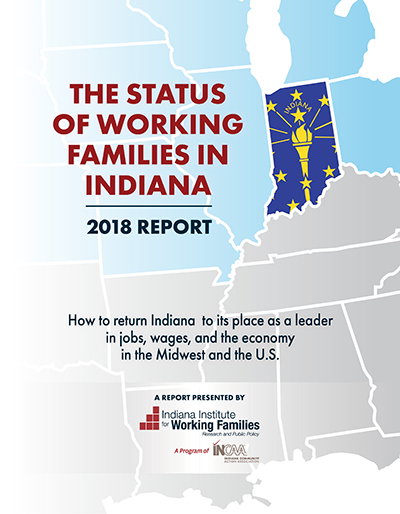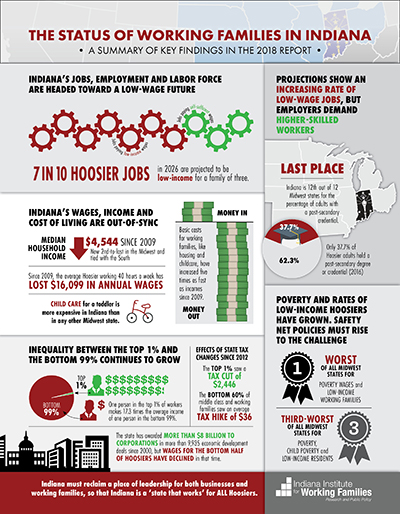The Status of Working Families:
2018 Report

Indiana once stood as a leader in the Midwest, ranking at least average or better than the region as a whole in family incomes, poverty, prime age employment rates, union coverage, and more. But after 2004, wages began to decline alongside policy choices that cut job quality standards and worker voice, weakened the safety net, and limited economic opportunities for middle- and low-income families. Indiana now resembles a Southern state as much as or more than our Midwestern neighbors when it comes to child poverty, low income families, rates of adults with a postsecondary degree, and more.
Indiana faces a choice of whether to continue down a southward-leading path of low-road policies, or to rebuild its economy for Hoosier families. By adopting a policy agenda for working families that improves Indiana’s jobs with higher wage and labor standards; strengthens protections for Hoosier families including repairing the safety net and crafting consumer and job safeguards; and increases economic mobility through improved access to education, rebalancing the state’s regressive tax and budget structure, and focusing economic development on strengthening Hoosier families and communities, Indiana can reclaim its place as a leader in the Midwest and in the nation.
AUGUST 2018
Executive Summary | Chapter Summaries | Policy Recommendations | Media Coverage
Executive Summary

At the turn of the 21st century, Indiana stood as a leader in the Midwest, ranking at least average or better than the region as a whole in family incomes, poverty, prime age employment rates, union coverage, and more. At the time, Indiana was nearing the crest of an upswing that started in the 1990s and that made the state competitive with others in the region and across the nation for economic outcomes for working families.
But after 2004, wages began to decline alongside policy choices that cut job quality standards and worker voice, weakened the safety net, and limited economic opportunities for middle- and low-income families. By the time the Great Recession hit in December 2007, Indiana was already falling behind the Midwest, and damage to Indiana’s highest-paying industries was exacerbated by a diminished capacity to serve the hundreds of thousands of Hoosiers forced out of a job or into underemployed without a policy structure to help them through tough times. In 2009, median Hoosier household wages fell below the average of the South’s, where they’ve remained virtually tied at best. In recent years, Indiana has gained the dubious distinction of having the highest rate of poverty wage jobs and low-income working families in the Midwest. Even accounting for cost of living, the state’s per capita personal income is now second-lowest in the region. The lasting damage has left scars on working families and the next generation coming into the workforce, with Indiana now in the bottom third of the Midwest in labor force participation, particularly among women and Hoosiers of color. These trends are expected to continue with state projections that by 2026, 7 in 10 of Indiana’s jobs will be in low-wage occupations for a family of three.
Indiana has historically been tightly allied with the Midwest, so falling to lower wage and job standards and quality of life shouldn’t be taken lightly. Indiana’s history and identity is inextricable from the Midwest and indeed the North, starting with the creation of the Indiana Territory from the Old Northwest; to Hoosiers following Indiana-raised Abe Lincoln’s lead in the Civil War with the second-highest rate of enlistment in the Union Army; even to the state’s involvement in founding the Midwest-centered Big Ten Conference. And although the South has wonderful, hard-working families with a rich culture of their own, its states have a history of policies resulting in lower wages and higher poverty rates that most Hoosiers hadn’t previously been accustomed to. But with outcomes including wages, poverty, and labor standards that now make Indiana appear as the northernmost digital indicator of the South, Indiana’s loss of a Midwestern quality of life represents a fundamental challenge to the state’s history, character, and pride.
Indiana is fundamentally different since these policy changes began in the mid-2000s, with outcomes that are apparent for working Hoosier families. Indiana now resembles a Southern state as much as or more than our Midwestern neighbors when it comes to child poverty, low income families, rates of adults with a postsecondary degree, and more. Indiana now has the lowest union coverage and highest rates of uninsured residents of any neighbor, including Kentucky. Meanwhile, basic costs for working families have gone up 31.9% since 2009, but incomes have only increased 6.3%. The brunt of changes to Indiana’s economy have especially been felt by low-income families, women, children, and Hoosiers of color. But the widening gap between basic costs and stagnant incomes is felt by families throughout the state, from the most urban to the most rural. And while Indiana’s neighbors have all faced similar economic challenges, Hoosiers have been left further behind the national recovery due to the state’s choices that further exacerbate inequality.
Indiana now faces a choice of whether to continue down a southward-leading path of low-road policies, or to rebuild its economy for Hoosier families. By adopting a policy agenda for working families that improves Indiana’s jobs with higher wage and labor standards; strengthens protections for Hoosier families including repairing the safety net and crafting consumer and job safeguards; and increases economic mobility through improved access to education, rebalancing the state’s regressive tax and budget structure, and focusing economic development on strengthening Hoosier families and communities, Indiana can reclaim its place as a leader in the Midwest and in the nation.
Chapter Summaries
Indiana’s Jobs, Employment, & Labor Force Headed Toward a Low-Wage Future: Over a decade since the beginning of the Great Recession, Indiana’s labor force is not fully recovered, and the status of Indiana’s jobs reflects a weak recovery that is also evident in the state’s relative standing compared to all 12 Midwestern states. While there are some areas where the state has done well, there are many more where Indiana doesn’t measure up, some attributed to policy decisions resulting in poor access to the job market, low-wage, low-quality jobs, loosened labor standards, and a weakened safety net. Indiana now has the highest rates in the Midwest for poverty-wage jobs and working poor families. Most troubling is an increasing reliance on low-wage occupations, with seven in ten jobs by 2026 projected to be low-income for a family of three.
Educational Attainment & Skills-Building for Hoosier Adults
As Indiana’s policymakers grapple with the reality of state projections of a low-wage future, but also employer demand for an increasingly-skilled labor supply, there is a short-term policy response that can bring long-term benefits to working families and the economy. By focusing policies on clearing non-academic barriers to educational attainment and skills training for low-income adults and underserved populations, Indiana has its best opportunity to quickly fulfill employer demand while making up ground on Midwestern neighbors in wages, labor force participation, and other employment standards for working families.
Wages, Income, and Cost of Living
After rising in the 1990s to compete with the Midwest average, Indiana’s median hourly wages hit their last peak of $17.70 in 2004 (in 2017 dollars) and have now fallen to $17.03, below the average of the U.S., Midwest, and even the South as whole. Indiana’s family and household incomes have also fallen in the 21st century, and now resemble the South more than the Midwest. Even accounting for cost of living, Indiana now has the second-to-last per capita income in the Midwest. And worse, basic costs for working families, such as housing and childcare, have increased five times as fast as incomes since 2009.
Poverty and Rates of Low-Income Hoosiers Have Grown, Safety Net Policies Must Rise to the Challenge
While Indiana began the 21st century as a leader among neighbors and the nation in providing paths to economic security, Indiana’s rates of poverty, and lack of self-sufficiency, now exceed most neighbors and resembles the South as much as the Midwest. These changes started well before the Great Recession and are tied to policy choices that made families less resilient to economic shocks, including weakened safety net programs, with results that continue to affect Hoosiers’ well-being nine years after the recession’s end.
Inequality, Taxes, and Economic Policy
As Hoosiers’ productivity has increased and profits have outpaced those of the Midwest and U.S. average, compensation lags behind the national rate. Inequality has grown and the top 1% has captured a larger share of incomes than the Midwest or the U.S. as a whole. The state’s tax structure has only exacerbated the income inequalities working families experience. Economic development policy should now focus on benefitting working Hoosiers, not corporations.
Policy Recommendations
In order to improve the status of working Hoosier families, Indiana must “raise the bar” for wages, job quality and labor standards, including for the largest occupations that are projected to power Indiana’s economy into the future. This means a policy focus on increasing Hoosiers’ pay from the bottom and middle up and modernizing Indiana’s labor standards to return to competitiveness and position the state for leadership. Policy recommendations include:
- Improve jobs: Raise Indiana’s minimum wage to $12 by 2026, and improve job quality standards including the ability to earn paid sick days, paid family and medical leave, fair scheduling, & pregnancy accommodation; policies that will improve worker health and strengthen families. Restore worker voice by repealing the so-called ‘Right to Work’ law and bans on public sector collective bargaining.
- Strengthen protections for Hoosier families: Add consumer protections against predatory lending and add renter protections to prevent evictions and increase housing stability. Repair Indiana’s safety net and introduce work sharing to protect jobs in temporary downturns.
- Increase economic mobility: Remove non-academic barriers to adult student completion and labor force participation by expanding access to necessary services such as childcare, transportation, affordable housing, and internet. Rebalance regressive state tax policies and refocus economic development to incentivize good jobs and community revitalization.
'Status of Working Families 2018' in the Media
|